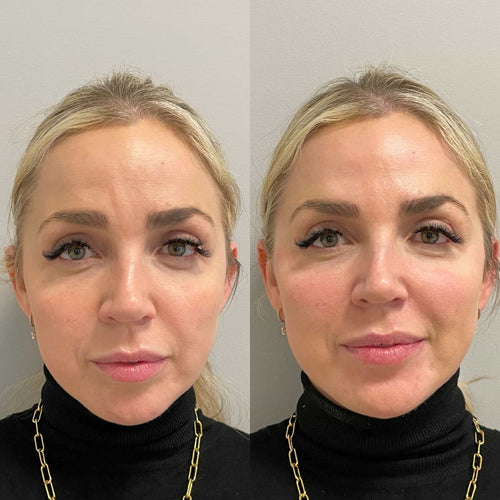Arrange a Consultation for Dermal Fillers with Dr. Laura Geige
Normal Function
Development and Anatomy
The preauricular gland, also known as a “gland of Bartholin,” is a small, sebaceous gland located in front of the ear, within a shallow depression called the preauricular sulcus. While its exact function remains somewhat debated among medical professionals, several theories exist about its role.
One prominent theory suggests that the preauricular gland plays a part in maintaining skin hydration and lubrication around the ear. Like other sebaceous glands, it produces an oily substance called sebum which can help keep the skin supple and prevent dryness or irritation.
Another theory proposes that the preauricular gland may have a role in scent marking or pheromone production. Some believe that its secretions could contain chemical compounds that convey information about an individual’s genetic makeup, health status, or reproductive availability to others.
During embryonic development, the preauricular gland develops alongside other structures in the head and neck region, including the ear canal and the parotid salivary gland. Its origin is thought to be connected with the development of sweat glands, which are also derived from epidermal cells.
Anatomically, the preauricular gland consists of a cluster of acini or alveoli, which are small sacs that produce sebum. These acini are connected to a network of ducts that carry the secretions to the surface of the skin. The size and prominence of the gland can vary significantly among individuals.
While the preauricular gland is typically benign and asymptomatic, it can sometimes become inflamed or infected, resulting in symptoms like pain, swelling, redness, and pus discharge. These conditions are often treated with topical antibiotics or oral medication.
Possible Evolutionary Purpose
The preauricular glands are small, vestigial structures found in humans and some other mammals. They are located just in front of the ear, in the fleshy part called the tragus.
The primary function of the preauricular glands is not fully understood, although they are believed to be remnants of scent-producing organs that were more prominent in our ancestors.
In other mammals, these glands often play a role in communication through scent marking. This could involve attracting mates, establishing territory, or conveying information about individual identity.
However, in humans, the preauricular glands are largely inactive and produce little to no odoriferous secretions. Their vestigial nature suggests that they have lost their primary function over evolutionary time.
One possible evolutionary purpose of the preauricular glands may be related to auditory function. Some researchers suggest that the glands could have played a role in lubricating or protecting the ear canal, or even enhancing sound transmission.
Another theory proposes that the preauricular glands were involved in thermoregulation, helping to dissipate heat from the head and face.
Despite these speculative explanations, the exact evolutionary purpose of the preauricular glands remains an area of ongoing research.
Clinical Significance
Abnormal Development
Clinical significance refers to the importance of a medical finding or condition in terms of its impact on a patient’s health, well-being, and prognosis.

Abnormal development can encompass a wide range of deviations from the typical course of growth and maturation. This can manifest in various systems and organs, including language development.
In the context of language development, abnormal development might involve delays or difficulties in acquiring and using language skills. These challenges can significantly affect a child’s communication, social interaction, and academic performance.
Clinical significance in language development is assessed by considering factors such as the severity, duration, and impact of the abnormality. A minor delay that does not interfere with daily functioning might not be considered clinically significant, whereas a profound impairment hindering communication and social relationships would be.
The preauricular gland is a vestigial structure located in front of the ear. Its primary function is unclear and it typically has no clinical significance unless it becomes inflamed or infected.
Infections
Clinical significance refers to the importance of a medical finding or condition in terms of its potential impact on patient health and management.
Infections can arise from various sources, including bacteria, viruses, fungi, and parasites. These infections can affect any part of the body and range in severity from mild to life-threatening.
The preauricular gland is a vestigial structure found in approximately 10% of people. It is located in the area of skin just in front of the ear.
Infections can occur within the preauricular glands, leading to inflammation and pain. This condition, known as preauricular lymphadenitis, is typically caused by bacterial infection.
Clinical significance of preauricular gland infections lies in their potential for complications. If left untreated, these infections can spread to surrounding tissues or even enter the bloodstream, resulting in systemic illness.
Diagnosis involves a physical examination and sometimes imaging studies. Treatment usually includes antibiotics.

Prevention strategies include good hygiene practices such as washing the ears regularly and avoiding the use of earplugs that trap moisture.
Uncertainties and Ongoing Research
Limited Understanding of Function
The exact function of the preauricular glands remains a mystery, despite ongoing research and various proposed theories.
Here’s what we know and don’t know:
-
Presence: These small, sometimes vestigial, glands are found in a pit just in front of the ear on many mammals, including humans.
-
Secretion: They secrete a fluid that can be oily or milky in appearance.
-
Varying Development: The size and prominence of these glands vary greatly between individuals, even within the same species.
-
Possible Functions: A number of hypotheses exist, but none are conclusively proven:**
-
Scent marking: Some researchers believe the secretion might be used in scent marking, similar to glands found in other animals.
-
Lubrication: The fluid could help lubricate the skin around the ear.
-
Protection: It may play a role in protecting the delicate skin around the ears from irritation or infection.
-
Thermoregulation: There’s speculation that the glands might contribute to temperature regulation, but evidence is lacking.
-
Evolutionary Remnant: Some scientists propose the preauricular glands are a vestigial structure, meaning they served a function in our ancestors but have lost their importance over time.
Get Your Dermal Filler Consultation with Dr. Laura Geige at It’s Me and You Clinic
Future research, including genetic studies and detailed analyses of the secretions, may shed more light on the true purpose of these intriguing glands. For now, the function of the preauricular glands remains a fascinating area of scientific inquiry.
Arrange a Consultation for Dermal Fillers with Dr. Laura Geige
Future Directions
Despite its presence in humans, the function of the preauricular gland remains a topic of ongoing debate and research.
One prominent theory suggests that it represents a vestigial structure, a remnant from our evolutionary past when the gland served a purpose in scent marking or other glandular secretions.
However, this theory is not without its challenges, as there is limited fossil evidence to support the notion of preauricular gland function in our ancestors.
Other hypotheses propose that the gland may play a role in thermoregulation, helping to regulate body temperature through sweat production.
Alternatively, some researchers speculate that it could be involved in immune responses, secreting substances with antimicrobial properties.
Currently, there is no definitive answer regarding the preauricular gland’s function.
Further research is needed to elucidate its precise role, potentially through comparative anatomical studies across species, analysis of glandular secretions, and investigations into its developmental origins.
Advances in genetic research may also shed light on the evolutionary history and potential functions of this intriguing anatomical feature.
The Lady London Apples and Pears Co. One One Three Online Line the Studio
- Why Doesn’t My Lip Filler Last - November 14, 2025
- What Is The Difference Between THC-Infused Drinks And THC Edibles? - November 12, 2025
- What Are The Best CBD Infused Gummies For Chronic Pain - November 9, 2025
